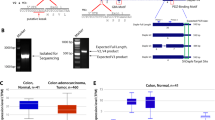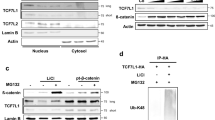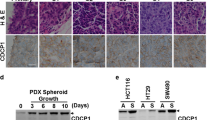Abstract
The canonical Wnt pathway (TCF4/β-catenin) has important roles during normal differentiation and in disease. Some Wnt functions depend on signaling gradients requiring the pathway to be tightly regulated. A key Wnt target is the transcription factor ZEB1 whose expression by cancer cells promotes tumor invasiveness by repressing the expression of epithelial specification markers and activating mesenchymal genes, including a number of Wnt targets such as LAMC2 and uPA. The ability of ZEB1 to activate/repress its target genes depends on its recruitment of corepressors (CtBP, BRG1) or coactivators (p300) although conditions under which ZEB1 binds these cofactors are not elucidated. Here, we show that TCF4 and ZEB1 reciprocally modulate each other’s transcriptional activity: ZEB1 enhances TCF4/β-catenin-mediated transcription and, in turn, Wnt signaling switches ZEB1 from a repressor into an activator. In colorectal cancer (CRC) cells with active Wnt signaling, ZEB1 enhances transcriptional activation of LAMC2 and uPA by TCF4/β-catenin. However, in CRC cells with inactive Wnt, ZEB1 represses both genes. Reciprocal modulation of ZEB1 and TCF4 activities involves their binding to DNA and mutual interaction. Wnt signaling turns ZEB1 into an activator by replacing binding of CtBP/BRG1 in favor of p300. Using a mouse model of Wnt-induced intestinal tumorigenesis, we found that downregulation of ZEB1 reduces the expression of LAMC2 in vivo. These results identify a mechanism through which Wnt and ZEB1 transcriptional activities are modulated, offering new approaches in cancer therapy.
This is a preview of subscription content, access via your institution
Access options
Subscribe to this journal
Receive 50 print issues and online access
$259.00 per year
only $5.18 per issue
Buy this article
- Purchase on Springer Link
- Instant access to full article PDF
Prices may be subject to local taxes which are calculated during checkout





Similar content being viewed by others
References
Clevers H, Nusse R . Wnt/β-catenin signaling and disease. Cell 2012; 149: 1192–1205.
Lien WH, Fuchs E . Wnt some lose some: transcriptional governance of stem cells by Wnt/β-catenin signaling. Genes Dev 2014; 28: 1517–1532.
Kiecker C, Niehrs C . A morphogen gradient of Wnt/β-catenin signalling regulates anteroposterior neural patterning in Xenopus. Development 2001; 128: 4189–4201.
Maretto S, Cordenonsi M, Dupont S, Braghetta P, Broccoli V, Hassan AB et al. Mapping Wnt/β-catenin signaling during mouse development and in colorectal tumors. Proc Natl Acad Sci USA 2003; 100: 3299–3304.
Luis TC, Naber BA, Roozen PP, Brugman MH, de Haas EF, Ghazvini M et al. Canonical Wnt signaling regulates hematopoiesis in a dosage-dependent fashion. Cell Stem Cell 2011; 9: 345–356.
Barker N, Huls G, Korinek V, Clevers H . Restricted high level expression of Tcf-4 protein in intestinal and mammary gland epithelium. Am J Pathol 1999; 154: 29–35.
Brabletz T, Jung A, Reu S, Porzner M, Hlubek F, Kunz-Schughart LA et al. Variable β-catenin expression in colorectal cancers indicates tumor progression driven by the tumor environment. Proc Natl Acad Sci USA 2001; 98: 10356–10361.
Vermeulen L, De Sousa E, Melo F, van der Heijden M, Cameron K, de Jong JH et al. Wnt activity defines colon cancer stem cells and is regulated by the microenvironment. Nat Cell Biol 2012; 12: 468–476.
Hlubek F, Brabletz T, Budczies J, Pfeiffer S, Jung A, Kirchner T . Heterogeneous expression of Wnt/β-catenin target genes within colorectal cancer. Int J Cancer 2007; 121: 941–948.
Sánchez-Tilló E, Siles L, de Barrios O, Cuatrecasas M, Vaquero EC, Castells A et al. Expanding roles of ZEB factors in tumorigenesis and tumor progression. Am J Cancer Res 2011; 1: 897–912.
Sánchez-Tilló E, Liu Y, de Barrios O, Siles L, Fanlo L, Cuatrecasas M et al. EMT-activating transcription factors in cancer: beyond EMT and tumor invasiveness. Cell Mol Life Sci 2012; 69: 3429–3456.
Takagi T, Moribe H, Kondoh H, Higashi Y . δEF1, a zinc finger and homeodomain transcription factor, is required for skeleton patterning in multiple lineages. Development 1998; 125: 21–31.
Siles L, Sánchez-Tilló E, Lim JW, Darling DS, Kroll KL, Postigo A . ZEB1 imposes a temporary stage-dependent inhibition of muscle gene expression and differentiation via CtBP-mediated transcriptional repression. Mol Cell Biol 2013; 33: 1368–1382.
Liu Y, Lu X, Huang L, Wang W, Jian W, Dean KC et al. Different thresholds of ZEB1 are required for Ras-mediated tumour initiation and metastasis. Nat Commun 2014; 5: 5660.
Aigner K, Dampier B, Descovich L, Mikula M, Sultan A, Schreiber M et al. The transcription factor ZEB1 (δEF1) promotes tumour cell dedifferentiation by repressing master regulators of epithelial polarity. Oncogene 2007; 26: 6979–6988.
Spaderna S, Schmalhofer O, Hlubek F, Berx G, Eger A, Merkel S et al. A transient, EMT-linked loss of basement membranes indicates metastasis and poor survival in colorectal cancer. Gastroenterology 2006; 131: 830–840.
Sánchez-Tilló E, de Barrios O, Siles L, Cuatrecasas M, Castells A, Postigo A . β-catenin/TCF4 complex induces the epithelial-to-mesenchymal transition (EMT)-activator ZEB1 to regulate tumor invasiveness. Proc Natl Acad Sci USA 2011; 108: 19204–19209.
Sánchez-Tilló E, de Barrios O, Siles L, Amendola PG, Darling DS, Cuatrecasas M et al. ZEB1 Promotes invasiveness of colorectal carcinoma cells through the opposing regulation of uPA and PAI-1. Clin Cancer Res 2013; 19: 1071–1082.
Postigo A, Dean DC . ZEB represses transcription through interaction with the corepressor CtBP. Proc Natl Acad Sci USA 1999; 96: 6683–6688.
Postigo A . Opposing functions of ZEB proteins in the regulation of the TGFβ/BMP signaling pathway. EMBO J 2003; 22: 2443–2452.
Postigo A, Depp JL, Taylor JJ, Kroll KL . Regulation of Smad signaling through a differential recruitment of coactivators and corepressors by ZEB proteins. EMBO J 2003; 22: 2453–2462.
Sánchez-Tilló E, Lázaro A, Torrent R, Cuatrecasas M, Vaquero EC, Castells A et al. ZEB1 represses E-cadherin and induces an EMT by recruiting the SWI/SNF chromatin-remodeling protein BRG1. Oncogene 2010; 29: 3490–3500.
Hiendlmeyer E, Regus S, Wassermann S, Hlubek F, Haynl A, Dimmler A et al. β-catenin up-regulates the expression of the urokinase plasminogen activator in human colorectal tumors. Cancer Res 2004; 64: 1209–1214.
Hlubek F, Jung A, Kotzor N, Kirchner T, Brabletz T . Expression of the invasion factor laminin γ2 in colorectal carcinomas is regulated by β-catenin. Cancer Res 2001; 61: 8089–8093.
Lamouille S, Xu J, Derynck R . Molecular mechanisms of epithelial-mesenchymal transition. Nat Rev Mol Cell Biol 2014; 15: 178–196.
Rosin-Arbesfeld R, Townsley F, Bienz M . The APC tumour suppressor has a nuclear export function. Nature 406: 1009–1012.
Peña C, García JM, García V, Silva J, Domínguez G, Rodríguez R et al. The expression levels of the transcriptional regulators p300 and CtBP modulate the correlations between SNAIL, ZEB1, E-cadherin and vitamin D receptor in human colon carcinomas. Int J Cancer 2006; 119: 2098–2104.
Palmer HG, Anjos-Alfonso F, Carmeliet G, Takeda H, Watt FM . The vitamin D receptor is a Wnt effector that controls hair follicle differentiation and specifies tumor type in adult epidermis. PLoS One 2008; 3: e1483.
Memezawa A, Takada I, Takeyama K, Igarashi M, Ito S, Aiba S et al. Id2 gene-targeted crosstalk between Wnt and retinoid signaling regulates proliferation in human keratinocytes. Oncogene 2007; 26: 5038–5045.
Moore AC, Amann JM, Williams CS, Tahinci E, Farmer TE, Martínez JA et al. Myeloid Translocation Gene Family Members associate with T-cell factors (TCFs) and influence TCF-dependent transcription. Mol Cell Biol 2008; 28: 977–987.
Postigo A, Sheppard AM, Mucenski ML, Dean DC . c-Myb and Ets proteins synergize to overcome transcriptional repression by ZEB. EMBO J 1997; 16: 3924–3934.
Daniels DL, Weis WI . β-catenin directly displaces Groucho/TLE repressors from Tcf/Lef in Wnt-mediated transcription activation. Nat Struct Mol Biol 2005; 12: 364–371.
Markowitz SD, Bertagnolli MM . Molecular origins of cancer: Molecular basis of colorectal cancer. N Engl J Med 2009; 361: 2449–2460.
Moser AR, Pitot HC, Dove WF . A dominant mutation that predisposes to multiple intestinal neoplasia in the mouse. Science 1990; 247: 322–324.
Leclerc D, Deng L, Trasler J, Rozen R . ApcMin/+ mouse model of colon cancer: gene expression profiling in tumors. J Cell Biochem 2004; 93: 1242–1254.
Koshikawa N, Giannelli G, Cirulli V, Miyazaki K, Quaranta V . Role of cell surface metalloprotease MT1-MMP in epithelial cell migration over laminin-5. J Cell Biol 2000; 148: 615–624.
Danø K, Behrendt N, Høyer-Hansen G, Johnsen M, Lund LR, Ploug M et al. Plasminogen activation and cancer. Thromb Haemost 2005; 93: 676–681.
Perissi V, Jepsen K, Glass CK, Rosenfeld MG . Deconstructing repression: evolving models of co-repressor action. Nat Rev Genet 2010; 11: 109–123.
Gilles C, Polette M, Mestdagt M, Nawrocki-Raby B, Ruggeri P, Birembaut P et al. Transactivation of vimentin by β-catenin in human breast cancer cells. Cancer Res 2003; 63: 2658–2664.
Gradl D, Kühl M, Wedlich D . The Wnt/Wg signal transducer β-catenin controls fibronectin expression. Mol Cell Biol 1999; 19: 5576–5587.
Hu MC, Rosenblum ND . Smad1, β-catenin and Tcf4 associate in a molecular complex with the Myc promoter in dysplastic renal tissue and cooperate to control Myc transcription. Development 2005; 132: 215–225.
Nateri AS, Spencer-Dene B, Behrens A . Interaction of phosphorylated c-Jun with TCF4 regulates intestinal cancer development. Nature 2005; 437: 281–285.
Verzi MP, Hatzis P, Sulahian R, Philips J, Schuijers J, Shin H et al. TCF4 and CDX2, major transcription factors for intestinal function, converge on the same cis-regulatory regions. Proc Natl Acad Sci USA 2010; 107: 15157–15162.
Sinner D, Rankin S, Lee M, Zorn AM . Sox17 and β-catenin cooperate to regulate the transcription of endodermal genes. Development 2004; 131: 3069–3080.
Wang J, Scully K, Zhu X, Cai L, Zhang J, Prefontaine GG et al. Opposing LSD1 complexes function in developmental gene activation and repression programmes. Nature 2007; 19: 882–887.
Battaglioli E, Andres ME, Rose DW, Chenoweth JG, Rosenfeld MG, Anderson ME et al. Rest repression of neuronal genes requires components of the hSWI/SNF complex. J Biol Chem 2002; 277: 41038–41045.
Chinnadurai G . The transcriptional corepressor CtBP: a foe of multiple tumor suppressors. Cancer Res 2009; 69: 731–734.
Zhang Q, Yoshimatsu Y, Hildebrand J, Frisch SM, Goodman RH . Homeodomain interacting protein kinase 2 promotes apoptosis by downregulating the transcriptional corepressor CtBP. Cell 2003; 115: 177–186.
Sierra J, Yoshida T, Joazeiro CA, Jones KA . The APC tumor suppressor counteracts beta-catenin activation and H3K4 methylation at Wnt target genes. Genes Dev 2006; 20: 586–600.
Acknowledgements
We are grateful to all researchers who provided us with reagents (see Materials and Methods and Supplementary Materials and Methods) and apologize to those whose work was cited indirectly through reviews owing to space limitations. This work was developed in the Centre de Recerca Biomèdica Cellex at IDIBAPS. The different parts of this study were independently funded by grants to AP from Fundació La Marató de TV3 (201330.10), Ministry of Economy and Competitiveness (BFU2010-15163 and SAF2014-52874- R), Leukemia Research Foundation, Academy of Medical and Health Sciences of Catalonia and the Balearic Islands, Avon Cosmetics S.A.U. (ACSAU), Catalan Agency for Management of University and Research Grants (AGAUR, 2014-SGR-475), European Commission of the European Union, Olga Torres Foundation, La Caixa Foundation (LCF), Spanish Association Against Cancer. EST’s salary was subsequently funded by grants from LCF, CIBERehd, ACSAU, and a Miguel Servet contract (MS13/00200) from Instituto de Salud Carlos III. OdB is recipient of a PhD scholarship from the Ministry of Education, Culture and Sports (FPU Program, AP2010-5489).
Author information
Authors and Affiliations
Corresponding author
Ethics declarations
Competing interests
The authors declare no conflict of interest.
Additional information
Supplementary Information accompanies this paper on the Oncogene website
Supplementary information
Rights and permissions
About this article
Cite this article
Sánchez-Tilló, E., de Barrios, O., Valls, E. et al. ZEB1 and TCF4 reciprocally modulate their transcriptional activities to regulate Wnt target gene expression. Oncogene 34, 5760–5770 (2015). https://doi.org/10.1038/onc.2015.352
Received:
Revised:
Accepted:
Published:
Issue Date:
DOI: https://doi.org/10.1038/onc.2015.352
This article is cited by
-
ZEB1 is a Subgroup-Specific Marker of Prognosis and Potential Drug Target in Medulloblastoma
NeuroMolecular Medicine (2023)
-
Tumour-associated macrophages enhance breast cancer malignancy via inducing ZEB1-mediated DNMT1 transcriptional activation
Cell & Bioscience (2022)
-
Transcriptional and post-transcriptional control of epithelial-mesenchymal plasticity: why so many regulators?
Cellular and Molecular Life Sciences (2022)
-
ZEB1 protects skeletal muscle from damage and is required for its regeneration
Nature Communications (2019)
-
TBL1 is required for the mesenchymal phenotype of transformed breast cancer cells
Cell Death & Disease (2019)



